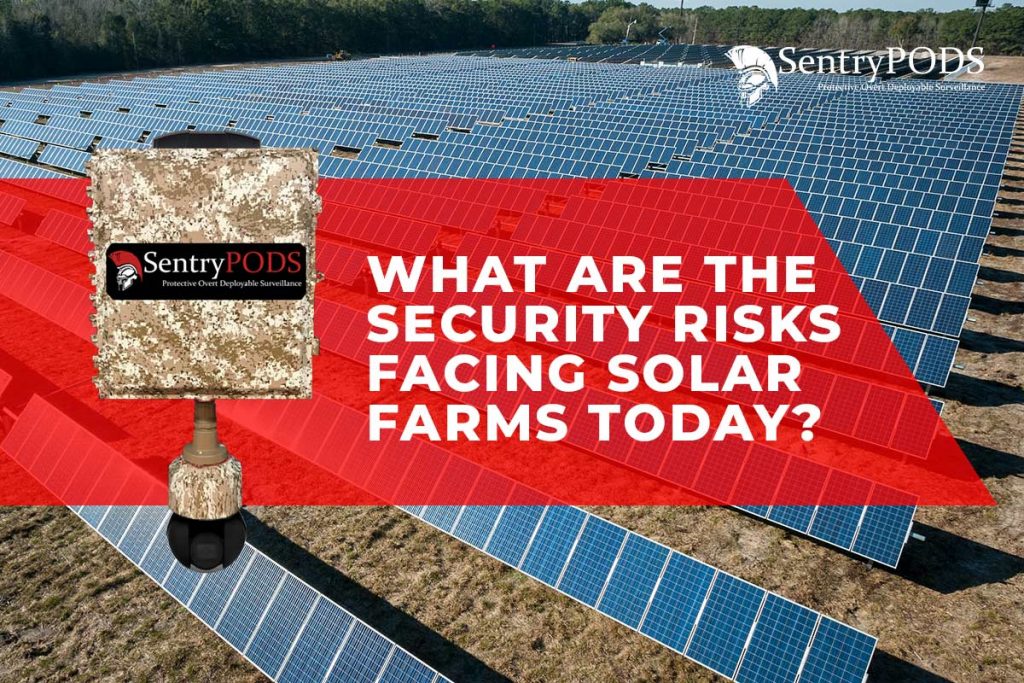What Are The Security Risks Facing Solar Farms Today?
 The importance of securing our nation’s electrical grids cannot be overstated, as this critical asset is vital for the functioning of the U.S. economy and national security. However, as the number of solar farms grows and the output of energy generated by these farms increases, it is necessary to evaluate and address solar farm security risks. Solar energy is fast becoming an integral part of the Energy Sector’s system and can provide additional resilience to the nation’s supply of power. But the growing popularity of solar farms means they are vulnerable to threats, just like other critical infrastructure sites. Addressing these solar farm security risks before a problem occurs is paramount to keeping the nation’s energy supply flowing without disruptions. With that being said, the need for critical infrastructure surveillance continues to grow. With that being said, the need for critical infrastructure surveillance continues to grow.
The importance of securing our nation’s electrical grids cannot be overstated, as this critical asset is vital for the functioning of the U.S. economy and national security. However, as the number of solar farms grows and the output of energy generated by these farms increases, it is necessary to evaluate and address solar farm security risks. Solar energy is fast becoming an integral part of the Energy Sector’s system and can provide additional resilience to the nation’s supply of power. But the growing popularity of solar farms means they are vulnerable to threats, just like other critical infrastructure sites. Addressing these solar farm security risks before a problem occurs is paramount to keeping the nation’s energy supply flowing without disruptions. With that being said, the need for critical infrastructure surveillance continues to grow. With that being said, the need for critical infrastructure surveillance continues to grow.
Solar Farm Security Risks
The isolated and sprawling nature of solar farms, which are often located in rural areas, means that there is very little chance of passers-by catching criminals in the act of stealing from a solar farm and raising the alarm to the proper authorities. The remote location of these facilities is very attractive to a variety of bad actors, who can easily create service disruptions for energy consumers if proper precautions are not taken. The biggest threats facing solar farms today are:
- Solar Farm Theft – the theft of solar panels and cables is a big concern at these facilities. Criminals can re-fit the panels or sell them, and the panels offer a resale value that criminals deem worth the risk. Cables and inverters also have a high resale value, making them a target for theft. The cost to repair the damage done by criminals is high, and even one set of cells being stolen from a facility can significantly reduce power output and revenue.
- Solar Farm Criminal Damage – the isolation of solar farms means that they are prone to criminal damage. Whether the damage comes from teenagers vandalizing the property or a more organized and planned attempt at criminal damage, the damages can cost operators hundreds of thousands of dollars in repairs and cause unplanned outages for consumers drawing from the grid.
- Solar Farm Cyberattacks – up until the past few years, the risk of cyberattacks on solar power systems has been relatively limited. The number of solar farms was smaller, and most solar inverters did not communicate with other devices for monitoring or control. But as the nation’s solar capacity grows and inverters become more advanced, the risk of cyberattacks on solar farms is growing.
Is A Cyberattack On A Solar Farm Dangerous?
Cybersecurity refers to the procedures and tools that organizations use to protect the interconnected systems that process, store, or transmit data to guarantee its integrity. As utility-scale solar projects become more popular, cyberattacks on solar farms can impact a larger network of consumers, causing disruptions to thousands of households and businesses. Identifying solar farm security risks and keeping these facilities safe from digital threats are necessary to maintaining operational continuity and revenue as well as ensuring the production of energy without disruption.
Solar energy systems are connected to the electrical grid through power electronic devices like inverters and may have frequent communication with utility control and automation systems. If an inverter’s software is not kept updated and secure, the data it sends between solar panels and the grid can be hacked and manipulated. A hacker could take advantage of unsecured systems to target the supervisory controls, allowing them to make an unauthorized change to the power supply and alter the voltage or electrical current that the inverter delivers onto the grid and into homes. Alternatively, a hacker could embed a code into the inverter to spread malware throughout the power system, causing it to fail. These consequences are serious, making cyberattacks one of the largest solar farm security risks facing the energy sector today.
Securing Solar Farms Against Bad Actors
With all the solar farm security risks facing the energy sector, what is the best way to protect these facilities and ensure an uninterrupted supply of energy for homes and businesses? The answer to this question can be found in a combination of physical deterrents and technology.
- Perimeter fencing – fencing acts as a deterrent as well as restricting access. Perimeter fencing also restricts view, so that the quality and quantity of panels may be hidden from view. Finally, a secure perimeter makes the facility difficult to access by vehicle, which means thieves are more likely to think twice if they are unable to transport the panels off-site.
- Remote surveillance – the size and remote location of solar farms mean that surveillance is a must. 24/7 remote surveillance, monitored by off-site professionals, means that a security breach can be responded to immediately if an alarm is set off. Cameras that record activity also means that you have evidence of criminal activity if it occurs.
- Infrared lighting – this added security measure provides enough light to allow cameras to monitor and record activity, but it is also indiscernible to the naked eye and does not cause light pollution.
- Video analytics – an intelligent video analytics platform that can be integrated with existing operational systems helps reduce the number of false alarms and allows security personnel to concentrate on genuine solar farm security risks.
By using a combination of physical deterrents and advanced technologies, solar farm operators can guard against both physical attacks and cyberattacks, ensuring the safety and stability of the nation’s electric grid.
To learn more about the technology that can help secure your solar farm, click here.

Brent Canfield
CEO and Creator of SentryPODSBrent Canfield, CEO, and founder of Smart Digital and SentryPODS, founded Smart Digital in 2007 after completing a nine-year active-duty career with the United States Marine Corps. During the 2016 election cycle, he provided executive protection for Dr. Ben Carson. He has also authored articles for Security Info Watch.

